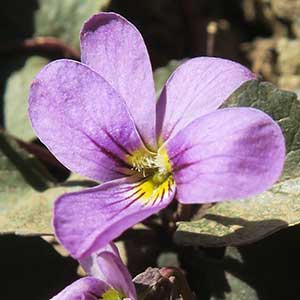Viola flettii
Viola tomentosa
Flett's violet, Olympic violet, rock violet
felt-leaf violet, woolly or felt-leaf or feltleaf violet, woolly violet
1–3, ascending to erect, mostly glabrous, on caudex from fleshy rhizome.
1–3(–5), prostrate or decumbent to erect, leafy proximally and distally, densely white-tomentose, from usually vertical, subligneous rhizome.
basal and cauline;
basal: 1–3;
stipules linear-lanceolate, margins entire or with glandular processes, apex acuminate;
petiole 1.5–9.7 cm, mostly glabrous;
blade purple-tinted and –veined, broadly reniform to ovate, 0.9–2.4 × 1.2–4 cm, base cordate, margins finely crenate-serrate, eciliate, apex acute to obtuse, surfaces glabrous or sparsely pubescent along veins adaxially;
cauline similar to basal except: stipules ovate to lanceolate, margins entire or shallowly laciniate;
petiole 0.7–5.9 cm, usually glabrous;
blade 0.8–2.1 × 1.2–3.1 cm.
basal and cauline;
basal: 1–6;
stipules linear to broadly ovate-oblong, margins entire, sometimes with scattered glandular hairs, apex acute to obtuse;
petiole 2–6 cm, densely white-tomentose;
blade ± oblanceolate to elliptic, 1.5–5 × 1.4–2.1 cm, base attenuate, usually oblique, margins usually entire, rarely crenate distally, ciliate, apex acute to usually obtuse, mucronulate, surfaces densely white-tomentose abaxially, strigose adaxially;
cauline similar to basal except: stipules ovate, lanceolate, oblanceolate, or oblong, margins entire or toothed, densely ciliate with white hairs;
petiole 1.5–3.5 cm;
blade 1.8–4 × 0.6–1.1 cm.
1.8–7.1 cm, usually glabrous.
1–4 cm, densely white-tomentose.
sepals lanceolate, margins eciliate, auricles 0.5–1.5 mm;
petals soft reddish violet on both surfaces, all with yellow area basally, lower 3 dark violet-veined, lateral 2 bearded, lowest with white around yellow area, 10–15 mm, spur yellow, gibbous, 0.5–2 mm;
style head bearded; cleistogamous flowers axillary.
sepals lanceolate, margins ciliate-tomentose, auricles 0.5–1 mm;
petals deep lemon-yellow adaxially, upper 2 often brownish purple abaxially, lower 3 dark brown- to brownish purple-veined, lateral 2 bearded, lowest 6–11 mm, spur yellow, gibbous, 0.5–1.5 mm;
style head bearded; cleistogamous flowers absent.
± spherical, 5–9 mm, glabrous.
± spherical, 4–5 mm, densely white-tomentose.
dark brown to brownish purple, 2.5–3 mm.
brown with lighter brown mottling, 2.5–2.8 mm.
= 12.
Viola flettii
Viola tomentosa
Viola flettii is endemic to the Olympic Mountains of northwestern Washington. C. S. McCreary (2005) noted that although morphologically and ecologically distinct, V. cuneata, V. flettii, and V. ocellata are closely related.
(Discussion copyrighted by Flora of North America; reprinted with permission.)
Viola tomentosa occurs in El Dorado, Nevada, Placer, Plumas, and Sierra counties. M. S. Baker (1949) reported that nearly every leaf axil of V. tomentosa produces a flower bud and that these buds produce chasmogamous flowers late in season instead of cleistogamous flowers, as do other members of the V. nuttallii complex.
Viola tomentosa hybridizes with V. purpurea; the hybrids appeared sterile (M. S. Baker 1949). J. Clausen (1964) reported a putative hybrid between V. tomentosa and V. sheltonii from one location in Sierra County.
(Discussion copyrighted by Flora of North America; reprinted with permission.)


